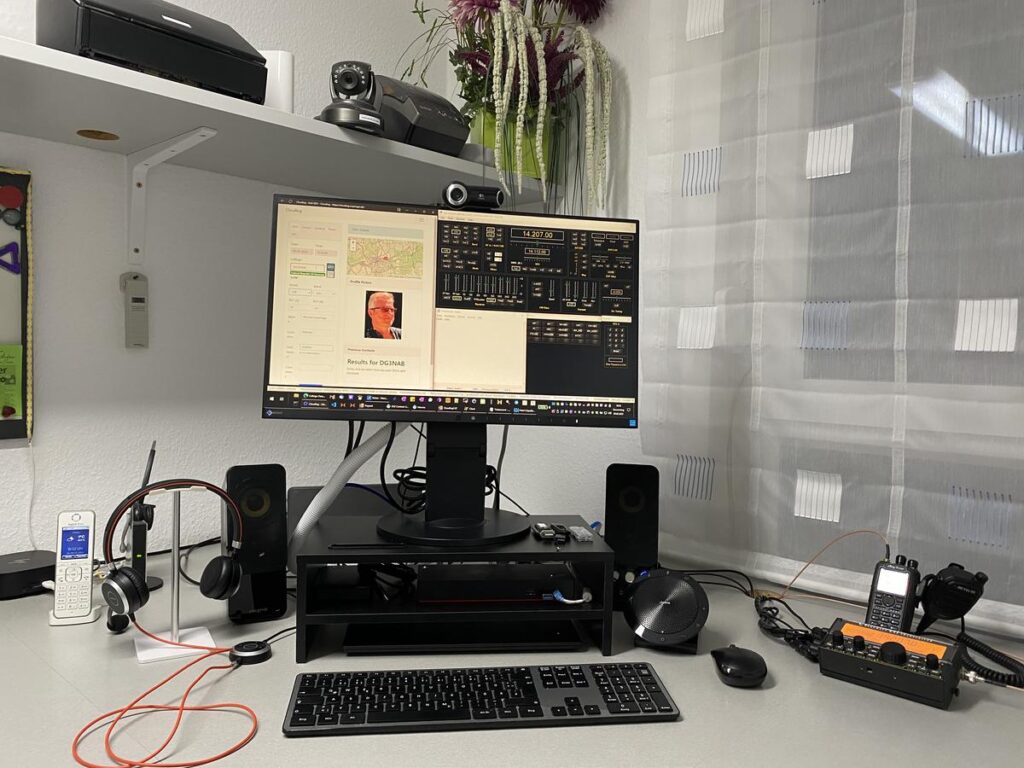In this article, I would like to describe how my amateur radio station is set up at home. Compared to other radio amateurs, I only have a very minimalistic setup 😊

My transceiver – the Elecraft KX-2
The heart of my radio station is the Elecraft KX-2. Yes, it is quite expensive. But it is also unbeatably small and handy and I can easily use it also for my portable activities. It also has a built-in tuner that can adapt just about any piece of wire as an antenna 😊 The downside is that it has a maximum output power of 10 watts.
At home, the KX-2 is connected to my laptop via an external Sabrent USB sound card. With that, I can not only work digital modes such as FT8 but I can also use the headset connected to the laptop for SSB operation.
For digital modes such as FT8, I also use an external USB fan so that my KX2 does not overheat when I operate it at 10 watts. Without additional ventilation, it can only be operated with a maximum of 5 watts in digital modes.
My headset – the Jabra Evolve 40
On my laptop I use the Jabra Evolve 40 headset. There’s no particular reason why I use this headset, I just had it already connected to my laptop for phone and web conferencing. However, I am very happy with it.
Software
Win4K3Suite – Transceiver control via the laptop
To control the KX2 from my laptop, I use the Win4K3Suite software from VA2FSQ. Apart from tuning the frequency (which I simply prefer to do using a tuning knob rather than the mouse), I actually control all the functions of my KX2 at home using this software. Especially the possibility to define macros is a great relief. For example, I can quickly switch between the settings for SSB, FT8, Winlink etc. with a single click.
KX2-PTTControl – PTT Control via the keyboard
KX2-PTTControl is a small Python script that I wrote to control important functions of my KX2 via the keyboard. This includes the PTT key (which I activate with the right Ctrl key) but also the two voice memories of the KX2, which I can control via two special keys on my keyboard that I don’t normally use. This allows me to transmit my callsign or a CQ call conveniently from the keyboard and I don’t have to use the small PTT button on the transceiver when speaking.
VoiceShaper – Optimized voice transmission
To improve my voice transmission even further, I use the VoiceShaper software. This software helps to fine-tune the voice modulation so that the voice reaches the recipient clearly and intelligibly. For me, VoiceShaper is a real game changer. I estimate that it makes my signal sound almost one S-level stronger. And with 10 watts of output power, that often makes the difference as to whether a QSO is still possible or not. I often get unsolicited compliments about my audio quality with it.
RM Noise – the noise killer
Unfortunately I have a relatively high noise floor at home (like probably the majority of all radio amateurs who don’t live in the flat countryside). I often can not read stations even though I could still reach them (especially if the other station doesn’t have a high noise level, e.g. during POTA/SOTA activities etc.). RM Noise makes it possible to filter out even weaker signals from the noise level. This allows me to establish clearer and more reliable connections despite unfavorable acoustic environments. For me, the software is often the decisive factor in making a QSO.
Antenna – Random Wire
Like many radio amateurs who do not own their own house/property, I also have the problem of setting up a suitable antenna. The antenna must not be visible to the residents and neighbors. I have therefore set up a 26 meter random wire antenna with very thin wire.
The wire hangs as an inverted-V antenna in a coniferous tree that overhangs our property from the neighbor (RED in picture).
The wire is terminated with a 9:1 UnUn and a choke. I also added a 16 m counterpoise wire (BLUE in picture)
From the UnUn a 13 m coax cable (Ecoflec 10 plus) runs to the window of the shack. There it then goes through the window with a 1m RG-316 coax cable.
The antenna can easily be tuned with the internal antenna tuner of the KX2 from the 80 m to the 10 m band.However, 80 m and 60 m are not very efficient because of the wire length.
As you can see, there are a lot of losses along the way. I’m therefore very surprised at how well everything still works with it 😊

Conclusion
As you can see, my station setup is far from optimal. Nevertheless, this setup works amazingly well.
In three years (as of February 2025), I have already been able to reach a total of 251 DXCC countries, 90 of them in SSB, the rest with digital modes (mainly FT8/FT4 and RTTY).
I hope you enjoyed this little insight into my station setup. If you have any questions or would like to share your own experiences, please write to me in the comments!
Vy 73, Michael (DG3NAB)

